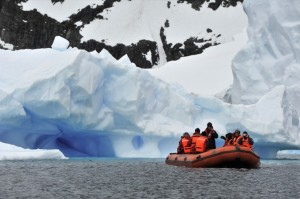
Editor's Note: This article is by Steve Gillick at Talking Travel, and is intended as a resource for travel agents but has useful information for a range of travel professionals. Travel educator Steve Gillick delivers sales, marketing and destination training to travel professionals via his consultancy Talking Travel. He served as president and COO of the Canadian Institute of Travel Counsellors from 2001 to 2012. Contact Steve at [email protected]. Read the original article on Travel Market Report.

Fueled by our modern-day quest for excitement, accomplishment and good health, the growing popularity of adventure and active travel has affected just about every travel category.
What is adventure travel? Adventure is in the mind of the beholder, so the client really defines what constitutes adventure.
This can involve everything from fishing in Northern Ontario to climbing the 750 stairs at Guatapé in Colombia, to bicycling to the Tombs of the Emperors in Hue, Vietnam, to sitting in a fish massage pool in Kuala Lumpur.
Here are nine tips to help travel agents expand into adventure travel.
1) Identify your audience. Travelers in every category and age group are candidates for adventure. The client may articulate their need – “I was thinking of climbing Kilimanjaro when I’m in Tanzania” – or she may only hint at her interest. (Remember, clients’ “want” and “wish” statements are gold and should be added into the client’s file in your database.)
2) Suggest an adventure. Ask questions of clients that will excite their interest in an adventure. For instance: Do you want to stay at the all-inclusive in Honduras for your entire vacation or would you like to spend a day in the rainforest canopy or hop over to Guatemala to visit the market in Chichicastenango? The idea is to open clients’ eyes to aspects of a destination that go beyond the resort stay or package tour. The adventures you suggest could end up being the highlight of their vacation.
3) Understand travelers’ motivations. Clients will have different reasons for including an adventure component in their travels. It might be bragging rights, personal accomplishment, overcoming a fear, creating shared experiences or team-building, celebrating nature or indulging in special interests such as photography, culinary, handicrafts or sustainability and conservation.
4) To gain expertise, take small steps. Start by specializing in one country or one region so you develop a comfort level with the product, then look to other destinations suggested by your clients or that interest you. You can take even smaller steps by choosing one activity that you’ve enjoyed personally. Begin by establishing a relationship with supplier(s), then offer the activity as part of an FIT, or add it to a package tour during a free afternoon or day.
5) Transfer skills. Many of the same professional skills you use when planning FITs apply to adventure travel. These include knowing how to access local knowledge and expertise, as well as travel information such as up-to-date travel advisories, visa information, travel health clinics, etc. You’ll need to expand your supplier relationships, including with airlines you may never have heard of, plus get up to speed on specialized and local suppliers, such as who rents bicycles or yaks, leads excursions to coffee plantations or caves, provides zip-line tours, etc.
6) Work closely with onsite suppliers. Ensure that you or a representative has met personally with onsite suppliers so they understand what you are trying to accomplish for your clients, as well as the motivation of the clients themselves. Otherwise the adventure component may be too intense or too lackluster for your client’s tastes.
7) Experience the adventure or activity yourself. Your clients will have a thousand and one questions relating to the fitness level required, stops and refreshments along the way, safety issues, insurance issues etc. Even for a simple elephant ride in Thailand there may be questions about whether they can expect to see baby elephants and even about the type of saddle – how to sit, is there anything to hold on to, do the saddles hurt the elephants – and on and on.
8) Use special touches to spark interest. Something in your agency or office or even your briefcase should convey adventure to the client. Ideas include: posters, your own photos on your ipad or laptop, masks, statues, pottery, costumes, music, snacks. The point is to help the client imagine themselves participating in the adventure activity while they are meeting with you.
9) Do post-trip research. Survey your clients for comments and suggestions. Be open-minded: Treat negative feedback as useful information for ways to improve the product or service and treat positive feedback as an opportunity to ask for referrals and testimonials.
Expanding into adventure travel – whether it’s entire adventure vacations or just a component of a trip – is a way to retain clients by adding memorable features to their travels. It will also help you expand your services to new customers.
This in turn will energize you and your staff and refresh your marketing edge.
